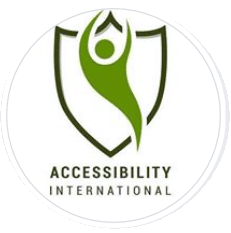Section 508 was added to the ADA in 1998, requiring all federal government agencies to make their electronic and information technology (EIT) accessible. However, the extent to which these digital accessibility requirements have been enforced is unclear. Every two years, Section 508 requires federal agencies to self-report to the Department of Justice on how their website achieves accessibility standards. The Attorney General then presents these to the President and Congress along with suggestions on how the websites could improve. These reports haven’t been available publicly since 2011.
Are federal websites actually accessible?
So are federal agencies actually addressing their websites’ accessibility shortcomings? The ITIF (Information Technology and Innovation Foundation) compiled a study of top government websites and the degree to which they are accessible. According to the ITIF, nearly half of the most frequently visited federal government websites fail a standard accessibility test on one of their top three web pages. The ITIF tested websites in two ways. It used automated checkers to catch technical accessibility elements. It also conducted qualitative testing using screen readers to ensure accurate text alternatives and keyboard navigation options.
Least accessible federal websites
Among the least accessible websites are the Energy Information Administration (which scored just 58 out of the possible 100 points for accessibility), the Marines website (65/100), National Highway Traffic Safety Administration (69/100), Energy Star (71/100), and the Census Bureau (71/100).
Most accessible federal websites
However, there were also several websites that scored a perfect 100 for accessibility. While there is always room for improvement, these websites were generally accessible for people using assistive technology. They include the Center for Disease Control (CDC), Department of Health and Human Services (DHHS), U.S. Citizen and Immigration Services, and the White House website.
The White House website leads the way
Of these, the White House website is perhaps the most significant, as it not only meets Section 508, which requires agencies to comply with Web Content Accessibility Guidelines (WCAG) 2.0, but goes further by complying with the more robust WCAG 2.1. The Accessibility Statement, which was recently restored to the site, specifically identifies WCAG 2.1 as its goal, which may indicate that other federal sites could be encouraged to follow suit.
Prioritizing diversity inclusion
As Biden settles into office, his administration has made diversity inclusion– including people with disabilities- a priority. This became clear as early as inauguration day, when the Pledge of Allegiance was both recited in English and signed for the deaf using American Sign Language (ASL). Even the updated website, which went live at 12:01 the morning of the inauguration and was designed in the short six weeks between the announcement of election results and the inauguration, was built to be accessible from the beginning. So what does
visible diversity inclusion from the top of the federal level mean for government agencies, and digital accessibility compliance in general?
Closer adherence to Section 508
As a representation of the top of the federal government, the White House website could be considered a role model for other sites by clearly indicating its dedication to WCAG compliance. This level of transparency and commitment to accessibility will likely be expected of other federal agencies as well. That might take the form of close attention to the self-reported compliance of Section 508, as well as closer scrutiny for websites that don’t fully comply with WCAG standards mandated by Section 508.
Clarified digital accessibility regulations for the private sector
While there haven’t been any new digital accessibility laws enacted since the inauguration, the Biden administration promised during their campaign to “aggressively enforce existing civil rights laws for people with disabilities, including the Americans with Disabilities Act.” Based on the precedent set by the newly-accessible White House website, it’s likely that those enforcements will apply to digital accessibility as well.
Digital accessibility regulations, like those required to settle Circuit Courts’ disagreement over whether or not websites are places of public accommodation, have been on the back burner since the Obama administration. However, legal experts believe there’s a good chance regulations will once again become a focus under the new administration.
This impacts the private sector significantly. Section 508 specifically requires compliance with WCAG 2.0 for federal websites. But the ADA, which applies to the private sector, does not mandate any specific set of requirements. In fact, it doesn’t mention the internet at all. When the ADA was passed in 1990, the internet was in its infancy, and not yet a daily necessity. While some courts have applied the ADA to websites, others have not. The disparity among courts and lack of specific regulations has caused confusion among businesses, frustration by people with disabilities, and thousands of ADA lawsuits filed annually.
Prioritizing the creation of digital accessibility standards
The Department of Justice (DoJ) could create specific regulations for businesses to follow that would eliminate this ambiguity. However, it has failed to address the issue since the Obama administration. However, with the renewed focus on accessibility, the Department of Justice may revisit the issue once again. If the DoJ does create standards for ADA website compliance, it may reference WCAG 2.1 to mirror the White House website. Courts in a number of digital accessibility cases have referenced or suggested WCAG as a remedy. Many countries around the world also recognize WCAG as the web accessibility standard. The European Union Web Accessibility Directive cites WCAG 2.1 specifically as the basis for its standards.
How can your organization be prepared?
No matter where you work, be it a federal agency or private organization, WCAG will probably soon be your digital accessibility standard, if it’s not already. Familiarize yourself with the four “pillars” of WCAG and how they apply to your website and digital resources. WCAG is organized as a set of guidelines, not a checklist. The guidelines are flexible enough to ensure they can apply to constantly evolving technology. Start by incorporating WCAG guidelines from the beginning of the website design process instead of retrofitting your website. It’s usually easier, faster, and cheaper to build in accessibility from the beginning.
Remember that digital accessibility doesn’t just apply to web pages. It applies to any digital resource your organization produces. That includes videos, audio files, and PDF files that live on your website or which your company otherwise distributes. Every type of content, whether it’s visually or audibly consumed, needs to be perceivable in at least one other way. That includes adding alt text to images so assistive technology can read it aloud to users, adding captioning and transcripts to audio files, including audio-described files of videos, and making PDF documents fully accessible to screen reader users.
WCAG covers most digital accessibility standards
While nearly half of federal websites aren’t accessible now, legal experts believe that’s likely to change soon. Stricter enforcement of Section 508 standards for federal government websites, and clearer digital accessibility standards for private sector websites may both be possible. Under the Obama administration, the DoJ “aggressively pursued enforcement actions” when companies violated accessibility requirements. The DoJ enforced very few actions for accessibility requirements under Trump. The Biden administration, being more similar to Obama’s administration than to Trump’s, will likely follow suit. To prepare your organization ahead of time and reach a broader audience, work towards compliance with WCAG, which helps make all of your digital resources accessible to all.
The post How the White House may Influence Digital Accessibility appeared first on Equidox.



